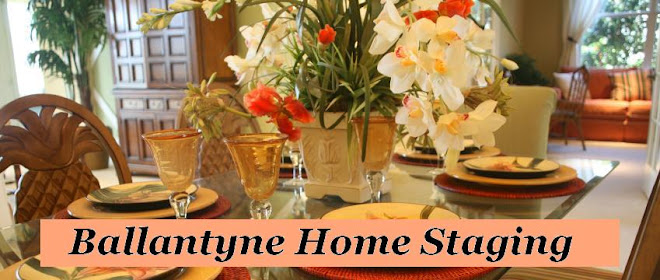Feng Shui is the system for arranging your surroundings in harmony and balance with the natural world. Feng Shui means “wind and water,” in Chinese and give us a practical and easy to follow set of guidelines for decorating.
There are three Power Principles of Feng Shui: Chi – energy; The Five Elements – Fire, Earth, Metal, Water, and Wood; and the Baqua – the chart used to map influential areas of a house, room, or even the lot a house will be or is built on.
There are a variety of tools available for those who would like to incorporate Feng Shui into their lives:
Color – which adds emotion. The Five Elements are represented by colors, shapes & materials
Art – used to enhance Chi and create balance in spaces
Living plants & flowers – used to connect us with nature. Live plants can also absorb moisture in areas such as the kitchen and bathroom. The best plants to use in these two rooms are upright growing.
Water features – used for calming effect and to attract Chi
Wind Chimes – used to attract Chi
Mirrors and crystals – used to attract, or slow down and redirect Chi. Be careful to no place a mirror incorrectly as this will have the opposite effect of attracting negative energy to an inappropriate place.
Feng Shui is a great set of guiding principles for home stagers and interior decorators – and at Ballantyne Home Staging we use elements of Feng Shui with each client
www.ballantynehomestaging.com | 980.322.5825 | carol@ballantynehomestaging.com
Thursday, November 18, 2010
Thursday, November 11, 2010
Space Planning Tips for Large Rooms
The great challenges with these spaces are simply defining areas and creating some sense of intimacy in the place. For these reasons, it is extremely important to create separate areas in these rooms where furniture is not spread too far apart, somewhat like a room within a room. The goal is to create social settings where people can interact. Multiple seating areas in large spaces are much more practical than having to scream across the bowling alley to have a conversation, so here are big space tips to help you out.
1. Place area rugs to anchor a space. These can be angled to add visual interest.
2. Use larger scale furniture – oversized, overstuffed, and higher backs
3. Use larger scale artwork and accessories
4. Mix textures in the flooring, furnishings, accessories, and draperies to warm up the room.
5. Use warmer colors on the walls, as deeper hues tend to bring the walls in a bit.
6. Don’t forget the ceilings! In large rooms with soaring ceilings, consider painting the ceiling one shade darker than the walls to visually lower it a bit. This will also help to create a more intimate space.
www.ballantynehomestaging.com | 980.322.5825 | carol@ballantynehomestaging.com
1. Place area rugs to anchor a space. These can be angled to add visual interest.
2. Use larger scale furniture – oversized, overstuffed, and higher backs
3. Use larger scale artwork and accessories
4. Mix textures in the flooring, furnishings, accessories, and draperies to warm up the room.
5. Use warmer colors on the walls, as deeper hues tend to bring the walls in a bit.
6. Don’t forget the ceilings! In large rooms with soaring ceilings, consider painting the ceiling one shade darker than the walls to visually lower it a bit. This will also help to create a more intimate space.
www.ballantynehomestaging.com | 980.322.5825 | carol@ballantynehomestaging.com
Thursday, November 4, 2010
Space Planning tips for Small Rooms
I recently conducted a survey of REALTORSÒ to find out what they were most interested in learning from Home StagersÒ. The #1 answer, with 83.3% of all responses, was Space Planning. With such a large number of REALTORSÒ identifying space planning as a topic of interest, we'll do a series to cover the topic, starting with this particular blog on small spaces.
The first thing to do is consider what it takes to open up the space. This means that you can eliminate any piece of furniture or accessory that does not have a purpose, which might mean someone has to get rid of a sentimental sea shell from Spring Break '89, but it must be done. In small spaces, it is best to remove and avoid heavy draperies, going instead for simple window treatments such as roman shades or sheers hung high near the ceiling and touch the floor, creating a light, flowing feel.
Of course, the use of mirrors to reflect light is a nice visual enhancement in small spaces. But a poorly placed mirror will do you no good at all. In small rooms, good places to hang a mirror are above a table lamp to reflect light, or across from a window to bring the outside in. This only works if you have clean windows and a nice view. So, if you're overlooking the stockyard and/or haven't cleaned the windows in 2 or more years, do not hang a mirror across from the window.
Multi-Functional Furniture: In small spaces, it's important to minimize furniture scale & also consider multi-functional pieces. For example, if planning a small 1-bedroom apartment, consider a sleeper sofa no more than 72” wide or even a sleeper loveseat, with a small storage ottoman and end tables that have drawers for additional storage. Bedroom nightstands should always have drawers, and small closets should be augmented with over-the-door shoe hangers, a small two- or three-drawer dresser inside the closet, and several pegs on the side walls inside the closet for belts, ties, hand bags, etc.
The first thing to do is consider what it takes to open up the space. This means that you can eliminate any piece of furniture or accessory that does not have a purpose, which might mean someone has to get rid of a sentimental sea shell from Spring Break '89, but it must be done. In small spaces, it is best to remove and avoid heavy draperies, going instead for simple window treatments such as roman shades or sheers hung high near the ceiling and touch the floor, creating a light, flowing feel.
In small homes or apartments, a smooth flow of energy from room to room can be accomplished simply by using the same color in various shades throughout. It's also wise to keep the trim work painted the same throughout for continuity. When selecting furnishings for small spaces, remember that a monochromatic approach makes a room look larger. Splashes of color can be brought in with rugs, wall art and accessories.
 |
Multi-Functional Furniture: In small spaces, it's important to minimize furniture scale & also consider multi-functional pieces. For example, if planning a small 1-bedroom apartment, consider a sleeper sofa no more than 72” wide or even a sleeper loveseat, with a small storage ottoman and end tables that have drawers for additional storage. Bedroom nightstands should always have drawers, and small closets should be augmented with over-the-door shoe hangers, a small two- or three-drawer dresser inside the closet, and several pegs on the side walls inside the closet for belts, ties, hand bags, etc.
Glass top tables -- whether cocktail table, end table, night stand, or dinette -- keep a space feeling open and airy. Solid surface table tops block both space and precious light in small places. For this same reason, in small kitchens and galley kitchens, the use of glass fronts in the cabinets is a good way to open up the space. This can easily be done by removing the cabinet doors and inside panels, then replacing the panels with glass.
And if you're trying to sell a small house that has dark wood molding and cabinets, it's a good idea to have these painted to brighten up the space.
Look Up: Did you know that recessed lighting draws the eyes upward? By taking the eyes upward, these little lights can create a feeling of the ceilings being higher than they actually are in older homes.
Look Down: If possible, use only one style of flooring in small houses because different flooring in a small house makes the space feel disjointed. Remember the goal is to have seamless flow from room to room. Sometimes it's not practical, of course, because you don't want carpeting in the kitchen and bathroom; however, it is best to leave the flooring surfaces in small houses to only two if possible.
http://www.ballantynehomestaging.com/ | 980.322.5825 | carol@ballantynehomestaging.com
Subscribe to:
Posts (Atom)



